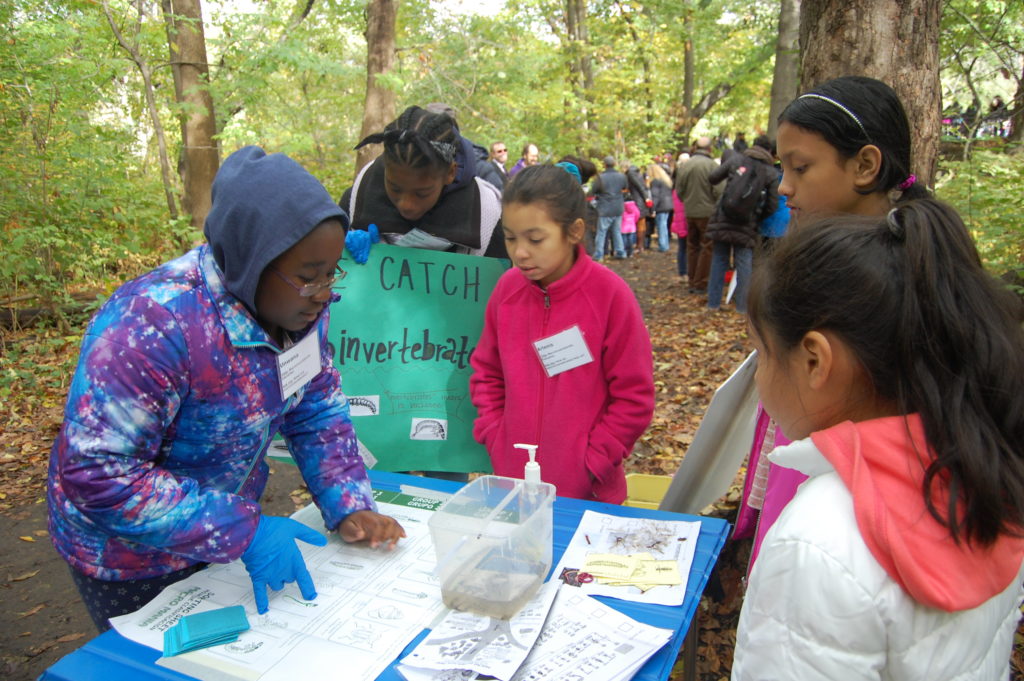
Photo courtesy Bronx Community Charter School
A pop-up museum on the Bronx River saw an exhibit that took a different tact: students opening it directly at the water source.
It was the kind of exercise that made for an interesting day at Bronx Community Charter School (BCCS) in Norwood, where students set up interactive exhibits at the Bronx River Forest, learning about the 24-mile waterway’s history and restoration efforts.
“It’s pretty incredible to go from our very urban environment and then walk behind our school building and be in the middle of a forest,” Sasha Wilson, one of BCCS’ founders leading the exhibit, said. “I think too often kids don’t get to be out in the woods, don’t get to explore nature. And I think that’s particularly true of kids of color in the Bronx. So it feels really important for us all to have this experience together and to really own the river.”
The one-day Bronx River Museum is a result of a six-week, all-school study. Each grade was assigned to study a different aspect of the Bronx River Forest, later presenting their findings along the Bronx River. Among the ecological subjects sixth graders learned was the existence of macroinvertebrates, tiny organisms that live in the Bronx River.
Their exhibit was near an opening of the forest near East 205th Street, with a trail leading to the body of water. Instructors handed nets to classmates and visitors looking to catch macroinvertebrates in the river. The first graders focused on plants and trees and they asked visitors to participate in an “observational drawing activity,” by drawing a leaf.
Sixth-grader Arlenis Nuñez said her favorite part of the all-school study was not just being able to catch organisms that live in the water, but also “helping other people learn about macroinvertebrates and showing them how to catch them.”
It was Nuñez’s enthusiasm of the river and forest that motivated BCCS staffers to organize the study and pop-up museum.
“So much of doing this study is about kids really feeling ownership over the river and the forest which is right here in their backyard,” Wilson said. “This[museum] was a chance for them to actually be at the river and share experiences at the river with their families and other visitors.”
This is the third year the school has conducted an all-school study of the Bronx River, but this was the first time they had set up a culminating exhibit at the Bronx River Forest. Previously, the students’ models and exhibits were presented in the classrooms. This year, the school decided to take the exhibits to the Bronx River Forest, located right behind the school.
In the weeks leading up to the event, students visited the Bronx River weekly to experience the natural setting and conduct field research.
Wilson added that BCCS is an institution that believes in activism, a root cause for the Bronx River’s revival that began decades ago. Once considered one of the top most polluted waterways in the United States — at one point it was used as a natural sewer to dispose of industrial wastes, the Bronx River eventually made a comeback that began in the 1970s. That effort was led by Bronx police Commander Anthony Bouza, who noticed a correlation between areas adversely affected by the Bronx River’s pollution and higher crime rates, and began rallying for the reclamation of the Bronx. In the mid-‘90s, their efforts gained more traction when more than 60 community organizations, public agencies, and businesses restored the river.
“We feel like we’re a part of that team, a part of that effort,” Wilson said about the charter school’s Bronx River Museum.




